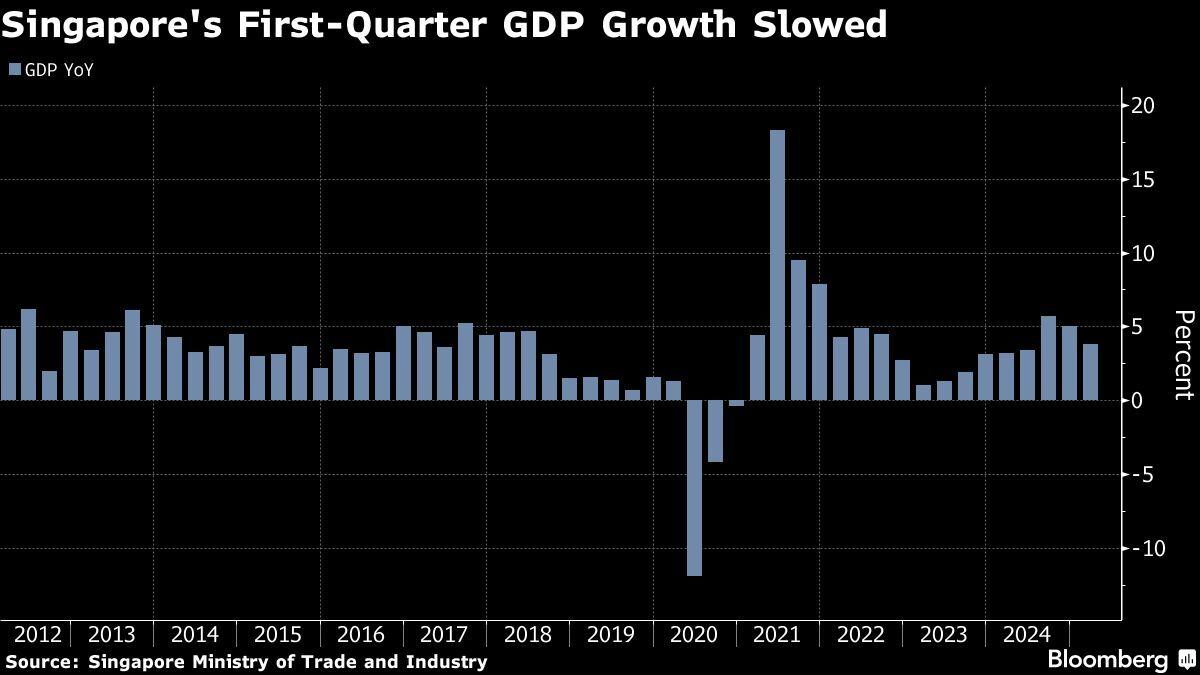
(April 14): Singapore’s central bank eased its monetary policy settings for a second straight review and warned that a persistent weakening in global trade will have “significant ramifications” on the city-state’s economy, with growth forecast to soften this year.
The Monetary Authority of Singapore (MAS), which uses the exchange rate as its main policy tool rather than interest rates, said on Monday it will reduce the slope of its policy band while leaving the width and centre unchanged — a decision widely expected by economists. The central bank also eased its settings in January following an extended pause that began in 2023.
“There are downside risks to Singapore’s economic outlook stemming from episodes of financial market volatility and a sharper-than-expected fall in final demand abroad,” the central bank said. “A more abrupt or persistent weakening in global trade will have significant ramifications on Singapore’s trade-related sectors, and in turn, the broader economy.”
In a separate release on Monday, Singapore’s Ministry of Trade and Industry downgraded the country’s 2025 growth forecast to 0%-2% from a previous 1%-3%. The city-state’s economy expanded 3.8% year-on-year in the first quarter, compared with expectations for a 4.5% increase.
The MAS decision comes as nations across the world try to understand the scope of US President Donald Trump’s planned tariff onslaught. Trump on Sunday insisted that he will apply tariffs to phones, computers and popular consumer electronics, dismissing a weekend exemption on those goods as temporary.
Financial markets have responded with extreme volatility. Policymakers are so far taking a circumspect approach, waiting to see how countries and, in particular, households and firms react. In recent days, central banks in New Zealand, India and Philippines cut interest rates on cooling price pressures and flagged potential for further easing.
“Prospects for global trade and GDP growth dimmed in early April,” the MAS said. “Given Singapore’s high trade dependency and deep integration with global supply chains, slowing global and regional trade as well as heightened policy uncertainty will weigh on the external-facing sectors, which could spill over into the domestic-oriented sectors.”
Recession risk
Singapore, which was hit with a 10% tariff, got off relatively lightly compared with China, but as an export-reliant economy the city-state’s success rests on the health of its trading partners. Prime Minister Lawrence Wong has warned that growth this year will be “significantly impacted” and the city-state could tip into a recession.
The Singapore dollar edged higher after the decision. It is up about 3.7% since the start of the year, becoming the second-best performing Asian currency after the Japanese yen as investors dump the US dollar amid rising tariff-related uncertainty.
“I wouldn’t rule out further easing,” said Selena Ling, head of research and strategy at Oversea-Chinese Banking Corp. “Reciprocal tariffs are currently still in play, with sectoral tariffs possibly to come. So a further downshift in growth and inflation could prompt further monetary policy easing, but fiscal policy will also come into play.”
She added that: “a technical recession is possible.”
The MAS allows the currency to move within a band, adjusting the slope, centre or width as needed to alter the pace of appreciation or depreciation. The central bank doesn’t disclose details of the basket, the band nor the pace of appreciation or depreciation — just whether they’ve changed.
Singapore, which imports the lion’s share of basic goods, has seen core inflation cool in recent months. The core inflation rate stood at 0.6% in February from a year earlier, the slowest pace since June 2021, and marking the fifth straight month it has decelerated. The next release is due on April 23.
Reflecting the easing in price pressures since the start of the year, the central bank now expects MAS core inflation to average 0.5%–1.5% in 2025, down from 1%–2% in its January statement.
Uploaded by Chng Shear Lane
- Chin Hin Property partners Fiamma to develop RM1.03 bil mixed-use project at KLCC area
- Hextar Technologies to emerge as Widad’s largest shareholder following Nilai land injection
- HexTech, Chin Hin, Fiamma, Mudajaya, Perak Transit, Meta Bright, NEXG, Ancom Nylex, MN Holdings, Sunsuria, T7
- InvestSarawak, China Energy Engineering ink MOU for RM6 bil renewable energy projects
- At the current price, is gold still a good hedge against Trump’s madness?

